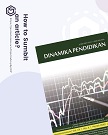Analysis of Technology Acceptance Model in Understanding of Students Behavior Intention in Use of Sikadu
(1) Department of Economy Education, Faculty of Economics, Universitas Negeri Semarang, Indonesia
(2) Department of Management, Faculty of Economics, Universitas Negeri Semarang, Indonesia
Abstract
The research aims to know the perception of students of ease use of Sikadu, the perception of students of usefulness use of Sikadu, and the impact of students’ perception of ease and usefulness of Sikadu. The approach of this research used quantitative research with descriptive analysis. Sample was students of Faculty of Economics, class of 2015 and 2016. The results of research indicates that students’ perception of the menu and display existing is easy to use in lecture activities up to the utilization of obtaining learning result information; students’ perception of the menu and display existing in Sikadu is very useful in lecturing activities up to the utilization of learning result information; the ease and usefulness in Sikadu encourages the students to use it although it is still rare used when it is seen from the frequency of using. Students mostly use it at the beginning and end of the semester; and the skill to operate computers. The need and demand to use Sikadu in academic administration becomes the main factors that encourage students to use Sikadu.
Keywords
Full Text:
PDFReferences
Adams, D. A., Nelson, R. R., & Todd, P. A. (1992). Perceived usefulness, ease of use, and usage of information technology: A replication. MIS quarterly, 21(3), 227-247.
Aristian, M. (2016). Faktor yang Mempengaruhi Niat Penggunaan E-Learning oleh Mahasiswa pada Universitas Atma Jaya Yogyakarta. Seminar Nasional Teknologi Informasi dan Komunikasi 2016. Yogyakarta, 18-19 Maret 2016.
Ajzen, I. (1991). The theory of planned behavior. Organizational behavior and human decision processes, 50(2), 179-211.
Alharbi, S., & Drew, S. (2014). Using the technology acceptance model in understanding academics’ behavioural intention to use learning management systems. International Journal of Advanced Computer Science and Applications, 5(1), 143-155.
Davis, F. D. (1989). Perceived usefulness, perceived ease of use, and user acceptance of information technology. MIS quarterly, 319-340.
Davis, F. D., Bagozzi, R. P., & Warshaw, P. R. (1989). User acceptance of computer technology: a comparison of two theoretical models. Management science, 35(8), 982-1003.
Davis, F. D. (1993). User acceptance of information technology: system characteristics, user perceptions and behavioral impacts. International journal of man-machine studies, 38(3), 475-487.
Gao, J., Friedrichs, M. S., Dongre, A. R., & Opiteck, G. J. (2005). Guidelines for the routine application of the peptide hits technique. Journal of the American Society for Mass Spectrometry, 16(8), 1231-1238.
Igbaria, M. (1994). An examination of the factors contributing to microcomputer technology acceptance. Accounting, Management and Information Technologies, 4(4), 205-224.
Kiraz, E. & Ozdemir, D. (2006). The Relationship between Educational Ideologies and Technology Acceptance in Preservice Teachers. Educational Technology & Society, 9(2), 152-165.
Klopping, I. & McKinney, E. (2004). Extending the Technology Acceptance Model and the TaskTechnology Fit Model to Consumer E-Commerce. Information Technology, Learning, and Performance Journal, 22(1), 35-48.
Refbacks
- There are currently no refbacks.

This work is licensed under a Creative Commons Attribution 4.0 International License.

.png)

.png)





